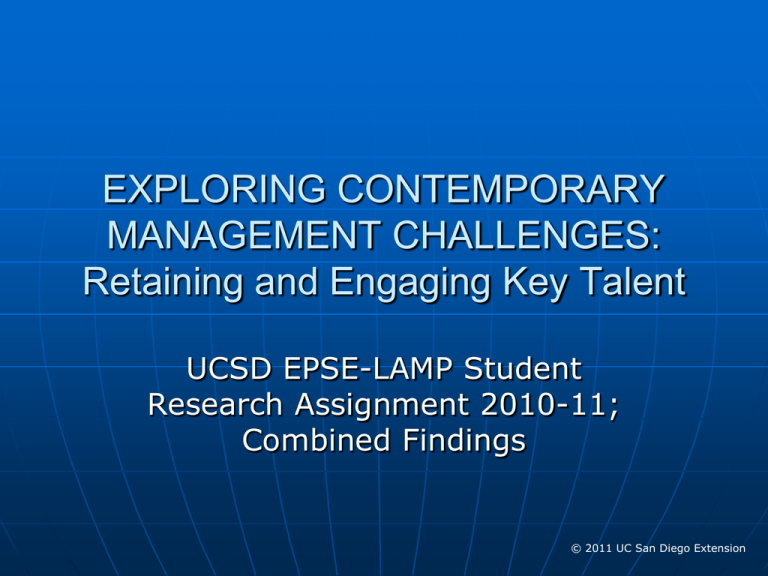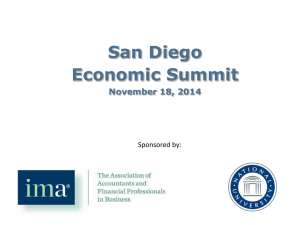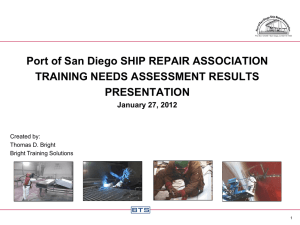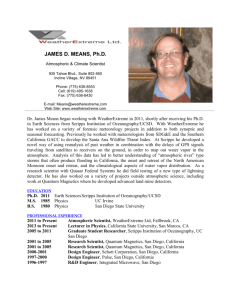Retaining and Engaging Key Talent
advertisement

EXPLORING CONTEMPORARY MANAGEMENT CHALLENGES: Retaining and Engaging Key Talent UCSD EPSE-LAMP Student Research Assignment 2010-11; Combined Findings © 2011 UC San Diego Extension OUTLINE The Assignment Information Received Team Themes Combined Conclusions © 2011 UC San Diego Extension THE ASSIGNMENT Understand the challenge – strategies to retain key talent and ensure they help the company move forward during difficult times Gather information Look for common themes (literature, interviews, survey) Document findings, present best practices, give personal analysis and recommendations © 2011 UC San Diego Extension INFORMATION RECEIVED Eighteen team reports • 86 researchers • 23 science and technology companies • 166 interviews • 1,677 survey respondents • Extensive literature review – 244 citations Swift and professional effort in completing the project and producing coherent and useful reports (five to eight weeks) © 2011 UC San Diego Extension Team Themes Active recognition – individual and team, know their contributions; relationship with supervisor very critical Mentoring – help them understand “why”, goal alignment, interested in growth and opportunity Training can backfire; too passive Put rising stars to work on most challenging projects, engage their mind and emotions Active engagement/sense of purpose reduces probability of leaving by 87% Uncertainty breeds attrition – need compelling goals and plan even during downturns © 2011 UC San Diego Extension Team Themes Implement “why stay” interviews Company culture can make a difference -- feeling respected, stability of the organization, sense of purpose and opportunity, feedback and coaching Stay on the pulse of employee feelings, mood, needs, increase during challenges, apply active development and coaching of key talent Keep salaries competitive, but focus time and effort on the work environment; difference between a good and great manager is active management of the work environment Recognize 2-3 people every day, but in a way they want (not everyone wants applause and awards) © 2011 UC San Diego Extension Team Themes Times of crisis are also an opportunity to grow, achieve, build relationships and be recognized Even the perception of unequal treatment destroys trust, distrust rapidly erodes engagement Mentoring and “free research time” are significant motivators to science/tech people If work-life balance becomes extreme in one direction, motivational factors lose their impact What employees need/want depends very much on the stage of their career Concept of “mutual loyalty” – it works both ways between employer and employee © 2011 UC San Diego Extension Team Themes Status (title and leadership responsibility) rate lower as motivational factors to science/tech professionals There may be gender differences in retention and motivation Actively address the disengaged; make the hard decisions when necessary “Knowing your opinions count” rates very high with science/tech professionals “Make visible the employee’s influence within the organization” as the best type of recognition © 2011 UC San Diego Extension COMBINED CONCLUSIONS Retention vs. motivation/engagement – two different things, consider each Active management, focus on individuals, understand what they need/want Challenge and growth is more valued than general training and rewards, or status and high profile recognition Especially during a downturn the company’s future, opportunity, and a sense of purpose is critical Trust and relationships can be a powerful point of leverage © 2011 UC San Diego Extension











